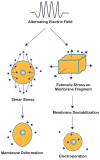Permeabilizing Cell Membranes with Electric Fields
- PMID: 34068775
- PMCID: PMC8126200
- DOI: 10.3390/cancers13092283
Permeabilizing Cell Membranes with Electric Fields
Abstract
The biological impact of exogenous, alternating electric fields (AEFs) and direct-current electric fields has a long history of study, ranging from effects on embryonic development to influences on wound healing. In this article, we focus on the application of electric fields for the treatment of cancers. In particular, we outline the clinical impact of tumor treating fields (TTFields), a form of AEFs, on the treatment of cancers such as glioblastoma and mesothelioma. We provide an overview of the standard mechanism of action of TTFields, namely, the capability for AEFs (e.g., TTFields) to disrupt the formation and segregation of the mitotic spindle in actively dividing cells. Though this standard mechanism explains a large part of TTFields' action, it is by no means complete. The standard theory does not account for exogenously applied AEFs' influence directly upon DNA nor upon their capacity to alter the functionality and permeability of cancer cell membranes. This review summarizes the current literature to provide a more comprehensive understanding of AEFs' actions on cell membranes. It gives an overview of three mechanistic models that may explain the more recent observations into AEFs' effects: the voltage-gated ion channel, bioelectrorheological, and electroporation models. Inconsistencies were noted in both effective frequency range and field strength between TTFields versus all three proposed models. We addressed these discrepancies through theoretical investigations into the inhomogeneities of electric fields on cellular membranes as a function of disease state, external microenvironment, and tissue or cellular organization. Lastly, future experimental strategies to validate these findings are outlined. Clinical benefits are inevitably forthcoming.
Keywords: alternating electric fields (AEFs), bioelectrorheology; cancer; cell membrane; cell modeling; electroporation; glioblastoma; tumor treating fields (TTFields); voltage-gated ion channel.
Conflict of interest statement
E.C. and C.B.P. are co-inventors on a patent application (United States application US16/502,255, filed July 3, 2019) titled “Using Alternating Electric Fields to Increase Cell Membrane Permeability”. E.C., A.N., and C.B.P. are co-inventors on a patent application (Stanford Docket S19-122, provisional application filed December 26, 2019) titled “TTFields normalizes aberrant glycolytic metabolism”. C.B.P. is a recipient of an AACR-Novocure Career Development Award for Tumor Treating Fields Research.
Figures





References
Publication types
LinkOut - more resources
Full Text Sources

